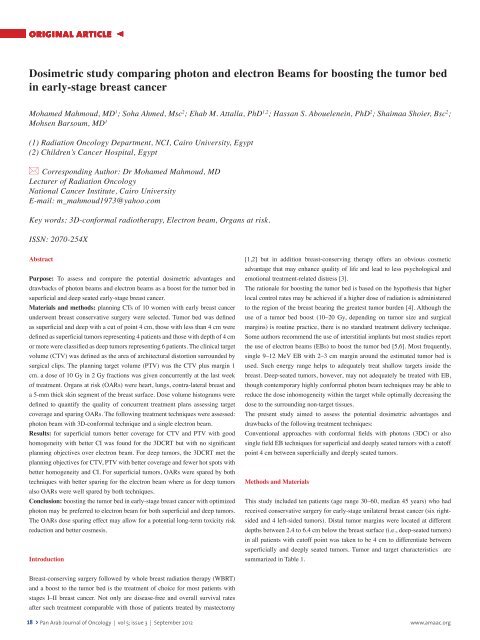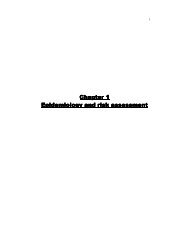Pan Arab Journal of Oncology - Arab Medical Association Against ...
Pan Arab Journal of Oncology - Arab Medical Association Against ...
Pan Arab Journal of Oncology - Arab Medical Association Against ...
You also want an ePaper? Increase the reach of your titles
YUMPU automatically turns print PDFs into web optimized ePapers that Google loves.
original article <<br />
Dosimetric study comparing photon and electron Beams for boosting the tumor bed<br />
in early-stage breast cancer<br />
Mohamed Mahmoud, MD 1 ; Soha Ahmed, Msc 2 ; Ehab M. Attalla, PhD 1,2 ; Hassan S. Abouelenein, PhD 2 ; Shaimaa Shoier, Bsc 2 ;<br />
Mohsen Barsoum, MD 1<br />
(1) Radiation <strong>Oncology</strong> Department, NCI, Cairo University, Egypt<br />
(2) Children’s Cancer Hospital, Egypt<br />
Corresponding Author: Dr Mohamed Mahmoud, MD<br />
Lecturer <strong>of</strong> Radiation <strong>Oncology</strong><br />
National Cancer Institute, Cairo University<br />
E-mail: m_mahmoud1973@yahoo.com<br />
Key words: 3D-conformal radiotherapy, Electron beam, Organs at risk.<br />
ISSN: 2070-254X<br />
Abstract<br />
Purpose: To assess and compare the potential dosimetric advantages and<br />
drawbacks <strong>of</strong> photon beams and electron beams as a boost for the tumor bed in<br />
superficial and deep seated early-stage breast cancer.<br />
Materials and methods: planning CTs <strong>of</strong> 10 women with early breast cancer<br />
underwent breast conservative surgery were selected. Tumor bed was defined<br />
as superficial and deep with a cut <strong>of</strong> point 4 cm, those with less than 4 cm were<br />
defined as superficial tumors representing 4 patients and those with depth <strong>of</strong> 4 cm<br />
or more were classified as deep tumors representing 6 patients. The clinical target<br />
volume (CTV) was defined as the area <strong>of</strong> architectural distortion surrounded by<br />
surgical clips. The planning target volume (PTV) was the CTV plus margin 1<br />
cm. a dose <strong>of</strong> 10 Gy in 2 Gy fractions was given concurrently at the last week<br />
<strong>of</strong> treatment. Organs at risk (OARs) were heart, lungs, contra-lateral breast and<br />
a 5-mm thick skin segment <strong>of</strong> the breast surface. Dose volume histograms were<br />
defined to quantify the quality <strong>of</strong> concurrent treatment plans assessing target<br />
coverage and sparing OARs. The following treatment techniques were assessed:<br />
photon beam with 3D-conformal technique and a single electron beam.<br />
Results: for superficial tumors better coverage for CTV and PTV with good<br />
homogeneity with better CI was found for the 3DCRT but with no significant<br />
planning objectives over electron beam. For deep tumors, the 3DCRT met the<br />
planning objectives for CTV, PTV with better coverage and fewer hot spots with<br />
better homogeneity and CI. For superficial tumors, OARs were spared by both<br />
techniques with better sparing for the electron beam where as for deep tumors<br />
also OARs were well spared by both techniques.<br />
Conclusion: boosting the tumor bed in early-stage breast cancer with optimized<br />
photon may be preferred to electron beam for both superficial and deep tumors.<br />
The OARs dose sparing effect may allow for a potential long-term toxicity risk<br />
reduction and better cosmesis.<br />
Introduction<br />
[1,2] but in addition breast-conserving therapy <strong>of</strong>fers an obvious cosmetic<br />
advantage that may enhance quality <strong>of</strong> life and lead to less psychological and<br />
emotional treatment-related distress [3].<br />
The rationale for boosting the tumor bed is based on the hypothesis that higher<br />
local control rates may be achieved if a higher dose <strong>of</strong> radiation is administered<br />
to the region <strong>of</strong> the breast bearing the greatest tumor burden [4]. Although the<br />
use <strong>of</strong> a tumor bed boost (10–20 Gy, depending on tumor size and surgical<br />
margins) is routine practice, there is no standard treatment delivery technique.<br />
Some authors recommend the use <strong>of</strong> interstitial implants but most studies report<br />
the use <strong>of</strong> electron beams (EBs) to boost the tumor bed [5,6]. Most frequently,<br />
single 9–12 MeV EB with 2–3 cm margin around the estimated tumor bed is<br />
used. Such energy range helps to adequately treat shallow targets inside the<br />
breast. Deep-seated tumors, however, may not adequately be treated with EB,<br />
though contemporary highly conformal photon beam techniques may be able to<br />
reduce the dose inhomogeneity within the target while optimally decreasing the<br />
dose to the surrounding non-target tissues.<br />
The present study aimed to assess the potential dosimetric advantages and<br />
drawbacks <strong>of</strong> the following treatment techniques:<br />
Conventional approaches with conformal fields with photons (3DC) or also<br />
single field EB techniques for superficial and deeply seated tumors with a cut<strong>of</strong>f<br />
point 4 cm between superficially and deeply seated tumors.<br />
Methods and Materials<br />
This study included ten patients (age range 30–60, median 45 years) who had<br />
received conservative surgery for early-stage unilateral breast cancer (six rightsided<br />
and 4 left-sided tumors). Distal tumor margins were located at different<br />
depths between 2.4 to 6.4 cm below the breast surface (i.e., deep-seated tumors)<br />
in all patients with cut<strong>of</strong>f point was taken to be 4 cm to differentiate between<br />
superficially and deeply seated tumors. Tumor and target characteristics are<br />
summarized in Table 1.<br />
Breast-conserving surgery followed by whole breast radiation therapy (WBRT)<br />
and a boost to the tumor bed is the treatment <strong>of</strong> choice for most patients with<br />
stages I–II breast cancer. Not only are disease-free and overall survival rates<br />
after such treatment comparable with those <strong>of</strong> patients treated by mastectomy<br />
18 > <strong>Pan</strong> <strong>Arab</strong> <strong>Journal</strong> <strong>of</strong> <strong>Oncology</strong> | vol 5; issue 3 | September 2012<br />
www.amaac.org









